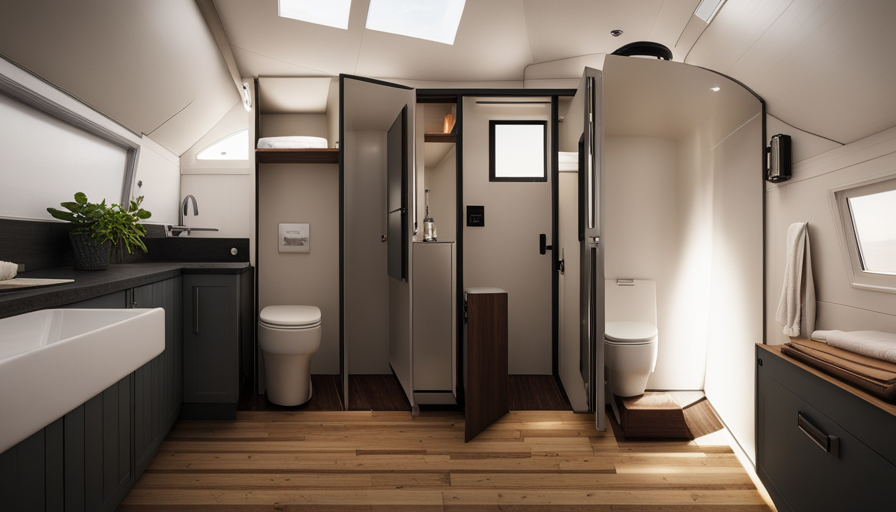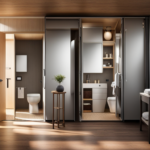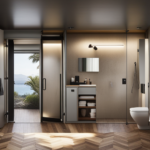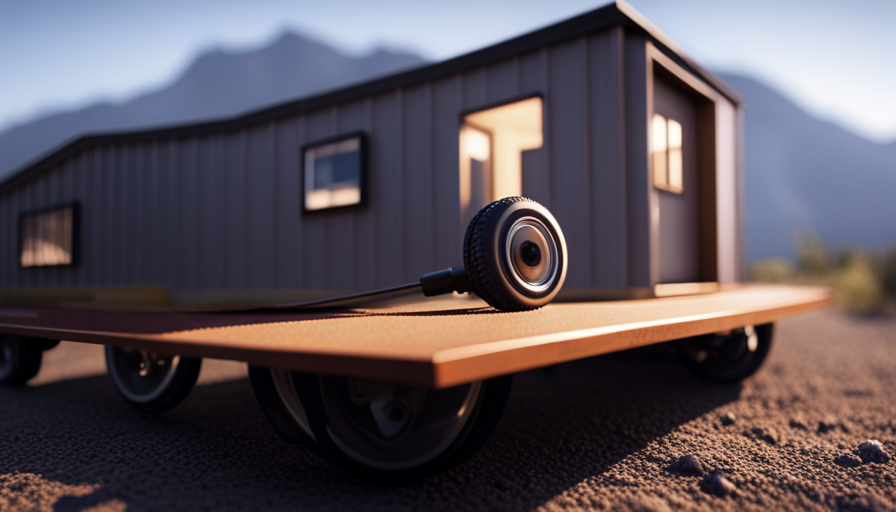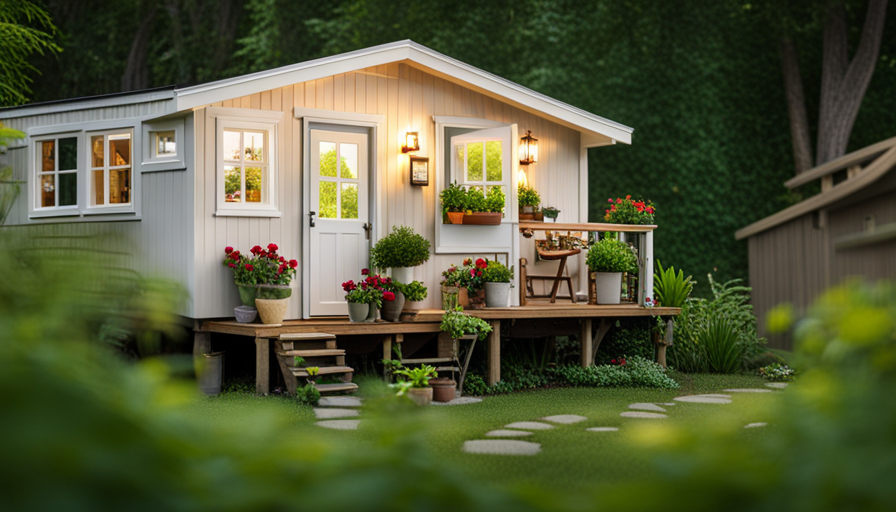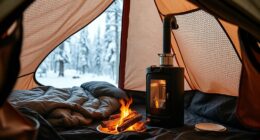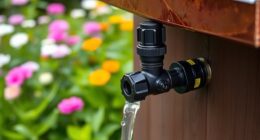When it comes to tiny homes on wheels, you may wonder about the functionality of the bathroom. Let me tell you, it’s a remarkable display of engineering and creativity! In such limited space, every inch is precious, and this extends to the bathroom area too.
From water and plumbing systems to space-saving designs, ventilation, and odor control, there are many factors to consider. Privacy and soundproofing are also crucial, ensuring that you can do your business without any unwanted interruptions. And let’s not forget about accessibility features, making sure that everyone can comfortably use the facilities.
For those looking to live off-grid, eco-friendly options are available too. In this article, we will explore the ins and outs of bathroom functionality in tiny houses on wheels, providing you with tips and considerations to maximize comfort and efficiency.
So buckle up and get ready to dive into the fascinating world of tiny house bathrooms!
Key Takeaways
- Tiny houses on wheels require careful consideration of water and plumbing systems, space-saving designs, ventilation, and odor control in their bathrooms.
- Waterless toilets, such as composting toilets, are a popular option in tiny houses on wheels as they eliminate the need for traditional plumbing systems and use natural processes to break down waste into compost.
- Water and plumbing systems in tiny houses on wheels can include options like freshwater tanks, greywater systems, and RV hookups for a traditional bathroom experience.
- Proper ventilation and odor control, along with privacy and soundproofing, are essential in tiny house bathrooms to maintain a comfortable and clean environment.
Types of Bathrooms in Tiny Houses on Wheels
There are several types of bathrooms in tiny houses on wheels, each offering a unique and efficient way to handle your daily hygiene needs.
One popular option is the waterless toilet, which eliminates the need for a traditional plumbing system. Waterless toilets, also known as composting toilets, use natural processes to break down waste into compost. They have a separate compartment for solid waste and liquid waste, which helps to control odors and maintain cleanliness. The solid waste is mixed with a composting material, such as sawdust, to facilitate decomposition. Over time, the waste is transformed into nutrient-rich compost that can be safely used in gardens or disposed of properly.
Composting toilets are a great choice for those who want to minimize water usage and reduce their environmental impact. They are also relatively easy to install and maintain, requiring regular emptying and occasional maintenance to ensure proper functioning. Additionally, composting toilets are odorless when properly managed and can be used in any climate.
When it comes to water and plumbing systems in tiny houses on wheels, there are a variety of options available. From traditional plumbing systems with freshwater tanks and greywater storage, to alternative options like rainwater harvesting and filtration systems, the choice depends on individual needs and preferences. These systems ensure a steady supply of water for various daily activities such as showering, washing dishes, and flushing toilets.
Water and Plumbing Systems
The water and plumbing systems in a tiny house on wheels ensure a seamless and convenient bathroom experience.
-
Types of Toilets:
- Composting toilets: These toilets use organic material to break down waste, eliminating the need for water. They’re environmentally friendly and require minimal maintenance.
- Incinerating toilets: These toilets use high temperatures to burn waste into ash. They’re compact and odorless, but they require a power source.
- Flush toilets: Some tiny houses on wheels have conventional flush toilets connected to a water and sewage system, similar to those in traditional homes.
-
Water Filtration:
- Water tanks: Tiny houses on wheels often have freshwater tanks that store water for daily use. These tanks can be refilled at designated water stations.
- Water filtration systems: To ensure clean and safe water for drinking and washing, tiny houses on wheels can be equipped with water filtration systems that remove impurities and contaminants.
-
Plumbing Systems:
- Greywater systems: These systems collect wastewater from sinks and showers and recycle it for non-potable purposes, such as watering plants.
- RV hookups: Some tiny houses on wheels can connect to external water and sewage systems using RV hookups, providing a more traditional bathroom experience.
The water and plumbing systems in a tiny house on wheels are designed to maximize efficiency and conserve resources. In the next section, we’ll explore space-saving designs that further enhance the functionality of these compact bathrooms.
Space-saving Designs
When it comes to space-saving designs in a tiny house on wheels, there are three key points to consider: compact fixtures, foldable or collapsible features, and creative storage solutions.
Compact fixtures, such as small toilets and sinks, are designed to maximize the functionality of a small bathroom area.
Foldable or collapsible features, like convertible tables or beds, provide flexibility and allow for multi-purpose use of limited space.
Creative storage solutions, such as utilizing vertical space or hidden compartments, are essential for maximizing storage in a tiny house.
Compact Fixtures
To maximize space in a tiny house on wheels, you’ll find compact fixtures that cleverly optimize every square inch. Compact storage is a key feature in the bathroom, ensuring that every item has its designated place.
From wall-mounted cabinets to built-in shelves, these fixtures efficiently utilize vertical space. Additionally, space optimization is achieved through clever design choices. For example, the sink in a tiny house on wheels may be smaller than a standard sink, but it still provides ample functionality. It may have a narrow profile or be designed to fit in a corner, allowing for more open floor space. The toilet may also be positioned in a way that maximizes available room.
With these compact fixtures, the bathroom in a tiny house on wheels becomes a practical and efficient space.
Transitioning into the next section, foldable or collapsible features further enhance the functionality of these compact fixtures.
Foldable or Collapsible Features
Not only do foldable or collapsible features add a touch of versatility, but they also bring a delightful element of surprise to the compact fixtures in a tiny house on wheels. These innovative features allow for maximizing space without compromising functionality. One example of such a feature is the foldable toilet. This space-saving marvel can be folded up and stored away when not in use, creating more room in the bathroom area. Another ingenious addition is the collapsible shower. With its ability to fold down flat against the wall, it saves valuable space and can easily be hidden when not needed. To give you a better idea of the foldable and collapsible features available, here is a table showcasing three examples:
| Feature | Description | Benefits |
|---|---|---|
| Foldable Toilet | A toilet that can be folded up and stored away when not in use. | Maximizes space in the bathroom area. |
| Collapsible Shower | A shower that can be folded down flat against the wall to save space. | Provides a functional shower without taking up much space. |
| Foldable Sink | A sink that can be folded up and tucked away when not needed. | Creates more countertop space in the bathroom area. |
By incorporating these foldable and collapsible features, a tiny house on wheels can offer a functional bathroom experience while minimizing the amount of space required. Now, let’s move on to the next section about creative storage solutions.
Creative Storage Solutions
Looking for clever ways to maximize storage in your compact living space? Let’s explore some creative solutions that’ll keep your belongings organized and easily accessible.
-
Utilize hidden storage: Incorporating hidden compartments within your bathroom design is a great way to optimize space. Consider installing a vanity with drawers or cabinets to discreetly store toiletries and towels.
-
Opt for vertical storage: Take advantage of vertical space by installing shelves or hanging organizers on the walls. This’ll free up valuable floor space and keep frequently used items within reach.
-
Think multipurpose: Look for furniture pieces that serve dual purposes, such as a toilet with built-in storage or a mirror with hidden shelves. This’ll maximize functionality while minimizing clutter.
By implementing these storage solutions, you can make the most of your limited bathroom space in your tiny house on wheels. Now, let’s delve into the next aspect: ventilation and odor control.
Ventilation and Odor Control
When it comes to the ventilation and odor control in a tiny house on wheels, there are three key points to consider:
-
Ventilation fans are essential for ensuring air circulation in the confined space, preventing moisture buildup and reducing the risk of mold and mildew.
-
Odor elimination strategies, such as using natural deodorizers or installing carbon filters, can help eliminate unpleasant smells and maintain a fresh environment.
-
Proper ventilation design is crucial for ensuring the efficient exchange of air, preventing the accumulation of odors, and creating a comfortable living space.
Ventilation Fans
One breeze from the ventilation fans will whisk away any unpleasant odors in the tiny house bathroom, leaving it as fresh as a daisy. Ventilation fans play a crucial role in maintaining a healthy and comfortable environment in a tiny house bathroom. These fans are designed to improve air circulation and remove moisture, preventing the growth of mold and mildew.
Here are four key benefits of using ventilation fans in a tiny house bathroom:
-
Improved air quality: Ventilation fans help to remove odors, smoke, and harmful pollutants from the bathroom, ensuring clean and fresh air.
-
Moisture control: These fans effectively remove excess moisture from the bathroom, preventing condensation and reducing the chances of mold and mildew growth.
-
Odor elimination: By constantly circulating the air, ventilation fans quickly eliminate any unpleasant odors, keeping the bathroom smelling fresh.
-
Energy efficiency: Modern ventilation fans are designed to be energy-efficient, consuming minimal power while providing effective air circulation.
With proper ventilation in place, it’s time to explore odor elimination strategies in the next section.
Odor Elimination Strategies
To keep your bathroom smelling fresh, you can try out different odor elimination strategies. One effective method is to use air fresheners specifically designed for small spaces, such as aerosol sprays or plug-in diffusers. These products release pleasant scents that help mask unpleasant odors. Another option is to use activated charcoal or baking soda, which can absorb and neutralize odors. Simply place a bowl of either substance in your bathroom to help eliminate any lingering smells. Additionally, proper ventilation design plays a crucial role in reducing odors. Ensuring that your tiny house on wheels has adequate airflow and ventilation will help remove stale air and prevent the buildup of unpleasant odors. By implementing these odor elimination strategies and incorporating a well-designed ventilation system, you can maintain a fresh and pleasant bathroom environment.
Proper Ventilation Design
Having a well-designed ventilation system in your tiny house on wheels is crucial, but have you ever wondered how it actually works? Proper ventilation is essential for maintaining a healthy and comfortable environment in your tiny bathroom.
Here are four key ventilation options to consider for your tiny house:
-
Windows: Installing windows in your bathroom allows for natural ventilation by allowing fresh air to enter and stale air to exit. It also helps to reduce moisture and prevent odors from lingering.
-
Exhaust Fan: An exhaust fan is a popular choice for tiny house bathrooms as it quickly removes moisture and odors. Be sure to choose a fan with the appropriate CFM (cubic feet per minute) rating for your bathroom size.
-
Ventilation Pipe: A ventilation pipe can be installed to direct stale air outside. It is connected to the exhaust fan and extends through the roof or wall of your tiny house.
-
Roof Vent: A roof vent is another effective method for ventilation. It allows hot air to escape from the bathroom, reducing humidity and preventing mold and mildew.
Proper ventilation options help control moisture and maintain a fresh bathroom environment in your tiny house.
In the next section, we’ll explore strategies for ensuring privacy and soundproofing in your tiny bathroom.
Privacy and Soundproofing
Privacy and soundproofing in the bathroom of a tiny house on wheels can be achieved through clever design and the use of materials that minimize noise and provide a sense of seclusion. When it comes to privacy solutions, a sliding pocket door or a curtain can be installed to separate the bathroom from the rest of the living space. These options not only save space, but also create a visual barrier that enhances privacy.
In order to reduce noise, it’s important to choose materials that absorb sound. Installing acoustic insulation in the walls and ceiling can help to minimize noise transfer between the bathroom and the rest of the tiny house. Additionally, using soundproofing materials for the floor can further reduce noise transmission.
To create a sense of seclusion, frosted or textured glass windows can be used to allow natural light into the bathroom while still maintaining privacy. Another option is to install window coverings that can be adjusted to control the amount of light and visibility.
Privacy and soundproofing in the bathroom of a tiny house on wheels can be achieved through a combination of clever design choices and the use of noise-reducing materials. These solutions not only provide a sense of seclusion but also ensure a peaceful and comfortable bathroom experience. When it comes to maintenance and cleaning, there are certain considerations to keep in mind.
Maintenance and Cleaning
When it comes to maintenance and cleaning in a tiny house on wheels, it’s important to establish a regular cleaning routine to keep the space tidy and organized. This routine should include tasks such as dusting, vacuuming, and sanitizing surfaces.
Additionally, proper waste disposal practices are crucial to ensure a clean and hygienic living environment. This involves effectively disposing of trash and recycling materials, as well as maintaining a well-functioning composting system if applicable.
Lastly, plumbing maintenance is essential in a tiny house on wheels to prevent any potential issues. Regularly inspecting and cleaning the plumbing system, including the toilet, sink, and shower, can help avoid clogs and leaks.
Regular Cleaning Routine
For a tiny house on wheels, maintaining a regular cleaning routine is essential to ensure a hygienic bathroom environment. Studies show that a clean bathroom reduces the risk of illness by up to 80%.
To establish a regular cleaning routine, it’s important to develop a schedule and stick to it. Start by gathering the necessary cleaning supplies, such as disinfectant, glass cleaner, and toilet cleaner.
Begin by removing any clutter and wiping down all surfaces, including countertops, mirrors, and fixtures. Next, scrub the toilet bowl using a toilet brush and cleaner, paying attention to hard-to-reach areas. Don’t forget to clean the shower or bathtub, wiping down the walls, and mopping the floor.
Maintaining a regular cleaning routine will help keep your bathroom in top condition and promote a healthy living space.
Now, let’s move on to discussing proper waste disposal practices.
Proper Waste Disposal Practices
To ensure a hygienic living space, it’s crucial for you to adopt proper waste disposal practices in your tiny home on wheels. One of the most popular waste disposal methods used in tiny houses is the use of composting toilets. These toilets are designed to separate liquids from solids, allowing for the decomposition of waste material.
The solid waste is mixed with organic material such as sawdust or coconut coir, creating an environment for aerobic decomposition. Over time, this waste turns into nutrient-rich compost that can be used in gardening. It’s important to follow the manufacturer’s instructions for maintaining and emptying the composting toilet regularly to prevent odors and ensure proper functioning.
Proper waste disposal practices not only promote cleanliness and hygiene but also contribute to sustainable living.
Moving onto plumbing maintenance tips, it’s important to keep the pipes clean and free from clogs.
Plumbing Maintenance Tips
Maintaining the plumbing system in your tiny home is like tending to a delicate garden, requiring regular care and attention to keep the flow of water running smoothly. To prevent clogs and ensure optimal performance, it is crucial to follow proper plumbing maintenance tips. First, always be mindful of what you flush down the toilet or pour down the sink. Avoid disposing of grease, oil, or large quantities of toilet paper. Additionally, periodically inspect the pipes for any signs of leaks or corrosion. Check the water pressure and adjust it if necessary. In case of any plumbing troubleshooting, such as slow draining or strange noises, address the issue promptly to prevent further damage. By taking these steps, you can maintain a functional and efficient plumbing system in your tiny home. Moving on to the next section about accessibility features, it’s important to consider the needs of all occupants in your tiny house.
Accessibility Features
In the tiny house on wheels, you’ll find accessible features in the bathroom that enhance its functionality. These features are designed with accessibility and universal design principles in mind to ensure that everyone, regardless of their physical abilities, can use and navigate the bathroom comfortably.
Here are five key accessibility features you’ll find in the bathroom:
-
Grab bars: Strategically placed grab bars provide stability and support, making it easier for individuals to move around the bathroom safely.
-
Roll-in shower: The bathroom is equipped with a roll-in shower that eliminates barriers, allowing individuals who use mobility aids such as wheelchairs to easily access and use the shower.
-
Adjustable height sink: The sink in the bathroom can be adjusted to different heights, accommodating individuals of various heights or those who use wheelchairs.
-
Lever handles: Lever handles on the faucets and doors make it easier for individuals with limited hand strength or dexterity to operate them.
-
Wide doorways: The bathroom has wide doorways to accommodate wheelchairs and walkers, ensuring easy entry and exit.
These accessible features in the bathroom provide convenience and independence for individuals with disabilities or mobility challenges. As we transition into the subsequent section about eco-friendly options, it’s important to consider how these features can also contribute to creating a sustainable and inclusive living space.
Eco-friendly Options
One way to create a sustainable and inclusive living space is by incorporating eco-friendly options into the design. In a tiny house on wheels, there are various eco-friendly materials and solar-powered options that can be utilized in the bathroom. These choices not only minimize the environmental impact but also contribute to a more self-sufficient and energy-efficient lifestyle.
When it comes to eco-friendly materials, there are several options to consider. For flooring, bamboo or cork can be used as sustainable alternatives to traditional hardwood. These materials are renewable and biodegradable, making them environmentally friendly choices. Additionally, utilizing low-flow toilets and water-saving faucets can significantly reduce water consumption in the bathroom.
Solar-powered options are also ideal for an eco-friendly tiny house bathroom. Installing solar panels on the roof can generate clean and renewable energy to power the bathroom lighting, ventilation, and even heated water for showers. This not only reduces reliance on fossil fuels but also saves on electricity bills.
To provide a deeper understanding of the eco-friendly options available, the following table showcases some examples:
| Eco-Friendly Materials | Solar-Powered Options |
|---|---|
| Bamboo flooring | Solar panels |
| Cork flooring | Solar-powered lights |
| Low-flow toilets | Solar-powered fans |
| Water-saving faucets | Solar water heaters |
Considering these eco-friendly options is crucial for those looking to create an environmentally conscious tiny house bathroom. By incorporating sustainable materials and solar-powered solutions, individuals can minimize their carbon footprint and live more self-sufficiently. Transitioning into the subsequent section about considerations for off-grid living, it is important to address other factors that contribute to a sustainable and functional bathroom.
Considerations for Off-grid Living
When it comes to off-grid living, there are several key considerations to keep in mind.
First and foremost, energy-efficient appliances are crucial for reducing energy consumption and maximizing the use of renewable energy sources.
Secondly, implementing water conservation strategies is essential for minimizing water waste and ensuring a sustainable water supply.
Finally, off-grid waste management is a critical aspect to address, as it involves properly disposing of waste and minimizing environmental impact.
These three factors are vital for creating a self-sufficient and eco-friendly off-grid living experience.
Energy-efficient Appliances
To maximize efficiency, you’ll want to consider using energy-saving appliances in your tiny house bathroom on wheels. When it comes to energy efficient appliances, there are a few options that can help reduce your energy consumption and save you money in the long run. Here are four key items to consider:
-
Low-flow showerhead: These compact fixtures reduce water usage without compromising on water pressure, allowing you to conserve water and energy.
-
Dual-flush toilet: This innovative toilet design offers two flushing options, allowing you to choose between a full flush or a half flush, depending on your needs. This helps to minimize water usage.
-
LED lighting: Installing LED lights in your bathroom can significantly reduce energy consumption compared to traditional incandescent bulbs.
-
Energy-efficient ventilation fan: Choosing a ventilation fan with an energy star rating can help remove excess moisture from your bathroom while using less electricity.
By incorporating these energy-saving appliances and fixtures into your tiny house bathroom, you can maximize efficiency and reduce your overall energy consumption.
Transitioning into the next section, let’s now explore water conservation strategies.
Water Conservation Strategies
Looking to reduce your water consumption and save money in the process? How can you implement water conservation strategies in your tiny house bathroom? One of the most effective ways is to use water saving techniques such as low-flow showerheads and faucets. These fixtures restrict the flow of water, reducing water usage without compromising functionality. Additionally, incorporating greywater recycling into your bathroom system can further conserve water. Greywater is the wastewater generated from sinks, showers, and washing machines, and it can be treated and reused for non-potable purposes like toilet flushing and irrigation. By implementing these strategies, you can significantly reduce your water usage and contribute to a more sustainable lifestyle. Transitioning into the subsequent section about ‘off-grid waste management’, it is important to consider how to effectively handle waste in your tiny house on wheels.
Off-grid Waste Management
If you want to effectively handle waste in your tiny house, consider implementing off-grid waste management techniques to ensure a sustainable and eco-friendly lifestyle.
Off-grid waste disposal is a crucial aspect of living in a tiny house on wheels. One popular method is the use of composting toilets, which are designed to separate liquid and solid waste. These toilets use natural processes to break down the waste into compost, which can then be used as fertilizer. Composting toilets are odorless, easy to maintain, and require no water or plumbing connections. Additionally, they can be installed in any location within the tiny house, providing flexibility in design.
By utilizing off-grid waste management techniques such as composting toilets, you can minimize your environmental impact and create a self-sufficient waste management system for your tiny house.
Transitioning to the next section, let’s explore some tips for maximizing comfort and efficiency in your tiny house.
Tips for Maximizing Comfort and Efficiency
When it comes to maximizing comfort and efficiency in a tiny house bathroom, organization and decluttering are key. By implementing smart storage solutions and keeping only the essentials, you can create a functional and streamlined space.
Additionally, creating a relaxing atmosphere in your tiny house bathroom can greatly enhance your overall experience. Consider using calming colors, soft lighting, and natural materials to achieve a spa-like ambiance.
Lastly, personalizing your tiny house bathroom allows you to add your own unique touch and make it truly feel like home. Whether it’s adding artwork, plants, or your favorite scented candles, these personal touches can make a big difference in creating a space that reflects your personality and style.
Organization and Decluttering
To maximize space in your tiny house, you’ll want to keep your bathroom organized and clutter-free. Here are some organization tips and decluttering strategies to help you achieve this:
-
Utilize vertical space: Install shelves or baskets on the walls to store towels, toiletries, and other bathroom essentials. This will free up valuable counter space.
-
Use storage containers: Invest in small bins or baskets to categorize and store items like makeup, hair products, and cleaning supplies. Labeling the containers will make it easier to find what you need.
-
Install hooks and racks: Hang towels, robes, and even toiletry bags on hooks or racks mounted on the walls or behind the bathroom door. This will keep things off the floor and create more space.
-
Purge regularly: Regularly go through your bathroom items and get rid of anything you no longer use or need. This will prevent clutter from accumulating and make your bathroom feel more spacious.
By following these organization tips and decluttering strategies, you can create a well-ordered and efficient bathroom in your tiny house.
Now, let’s move on to creating a relaxing atmosphere.
Creating a Relaxing Atmosphere
Immerse yourself in a tranquil oasis by incorporating soothing colors and soft lighting into your bathroom space. To create a relaxing atmosphere, opt for lighting fixtures that emit a warm, gentle glow. Consider installing dimmers to adjust the brightness according to your mood. Choose calming color schemes such as pastel blues, soft greens, or creamy neutrals to promote a sense of serenity. To highlight the importance of these elements, let’s look at the following table:
| Lighting | Colors | Atmosphere |
|---|---|---|
| Soft and warm | Pastel blues, soft greens, creamy neutrals | Tranquil and serene |
By carefully selecting relaxing lighting and calming color schemes, you can transform your tiny house bathroom into a peaceful retreat. In the next section, we will explore how to personalize your bathroom to make it truly your own.
Personalizing Your Tiny House Bathroom
In order to create a truly personalized tiny house bathroom, it’s essential to focus on two key aspects: personalized storage and bathroom decor.
When it comes to storage in a tiny house, every inch counts. Therefore, it’s important to utilize clever storage solutions that maximize the available space. Consider installing shelves, hooks, and storage bins to keep toiletries, towels, and other bathroom essentials neatly organized.
Additionally, incorporating decorative elements into your tiny house bathroom can add a touch of personality and create a visually appealing space. Choose a color scheme that reflects your personal style and use accessories such as artwork, plants, and rugs to create a cozy and inviting atmosphere.
By paying attention to personalized storage and bathroom decor, you can transform your tiny house bathroom into a functional and aesthetically pleasing oasis.
Frequently Asked Questions
How much water does a typical bathroom in a tiny house on wheels use?
In a typical bathroom in a tiny house on wheels, water usage can be minimized by implementing several water-saving tips. For example, using low-flow fixtures and aerators can significantly reduce water consumption. Additionally, alternative toilet options like composting toilets and incinerating toilets can greatly reduce the amount of water needed for flushing. By incorporating these water-saving measures, the bathroom in a tiny house on wheels can be designed to maximize efficiency and minimize water usage.
Can I install a composting toilet in a tiny house bathroom?
Yes, you can install a composting toilet in a tiny house bathroom. Composting toilets offer several benefits, such as water conservation and minimal odor. The installation process involves connecting the toilet to a ventilation system and providing a separate container for waste decomposition. The waste is broken down by natural processes, resulting in compost that can be safely disposed of. It’s important to follow the manufacturer’s instructions for proper installation and maintenance.
Are there any regulations or permits required for plumbing in a tiny house on wheels?
Regulations and permits are essential when it comes to plumbing in a tiny house on wheels. Before embarking on any plumbing work, it’s crucial to research and understand the local regulations and permits required.
These regulations may vary depending on the location and jurisdiction. It’s important to ensure that all plumbing work is done in compliance with these regulations to ensure safety and avoid legal issues.
How often do I need to empty the waste tank in a portable toilet?
I need to empty the waste tank in a portable toilet regularly to ensure proper waste disposal. The emptying frequency depends on the size of the tank and the number of occupants using the toilet.
Typically, I would need to empty the waste tank every 3-5 days or when it reaches 75% capacity. It’s important to follow proper waste disposal guidelines and use designated dumping stations to ensure environmental and hygiene safety.
Is it possible to have a bathtub or only showers in a tiny house bathroom?
When it comes to tiny house bathrooms, bathtub options can be limited due to space constraints. However, there are space-saving bathroom fixtures available that can provide a similar bathing experience. These fixtures, such as compact showers with built-in seating or deep soaking tubs designed specifically for small spaces, allow for relaxation and comfort without sacrificing functionality.
So, while having a traditional bathtub may not be feasible, there are still options available to create a luxurious bathing experience in a tiny house bathroom.
Conclusion
In conclusion, the bathroom in a tiny house on wheels is a marvel of engineering and design.
From the space-saving layouts to the eco-friendly options, every aspect has been carefully considered to maximize comfort and efficiency.
The ventilation and odor control systems ensure a fresh and pleasant environment, while the privacy and soundproofing features create a peaceful oasis.
The accessibility features make it suitable for people of all abilities, and the off-grid considerations allow for a self-sufficient lifestyle.
With these tips and techniques, the bathroom in a tiny house on wheels truly becomes a work of art.
Hi, I’m Emma. I’m the Editor in Chief of Tiny House 43, a blog all about tiny houses. While tree houses are often associated with childhood, they can be the perfect adult retreat. They offer a cozy space to relax and unwind, surrounded by nature. And since they’re typically built on stilts or raised platforms, they offer stunning views that traditional homes simply can’t match. If you’re looking for a unique and romantic getaway, a tree house tiny house might just be the perfect option.
